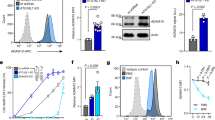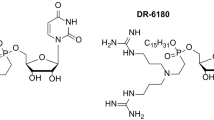Abstract
Gram-positive bacterial pathogens that secrete cytotoxic pore-forming toxins, such as Staphylococcus aureus and Streptococcus pneumoniae, cause a substantial burden of disease. Inspired by the principles that govern natural toxin-host interactions, we have engineered artificial liposomes that are tailored to effectively compete with host cells for toxin binding. Liposome-bound toxins are unable to lyse mammalian cells in vitro. We use these artificial liposomes as decoy targets to sequester bacterial toxins that are produced during active infection in vivo. Administration of artificial liposomes within 10 h after infection rescues mice from septicemia caused by S. aureus and S. pneumoniae, whereas untreated mice die within 24–33 h. Furthermore, liposomes protect mice against invasive pneumococcal pneumonia. Composed exclusively of naturally occurring lipids, tailored liposomes are not bactericidal and could be used therapeutically either alone or in conjunction with antibiotics to combat bacterial infections and to minimize toxin-induced tissue damage that occurs during bacterial clearance.
This is a preview of subscription content, access via your institution
Access options
Subscribe to this journal
Receive 12 print issues and online access
$209.00 per year
only $17.42 per issue
Buy this article
- Purchase on Springer Link
- Instant access to full article PDF
Prices may be subject to local taxes which are calculated during checkout






Similar content being viewed by others
References
Stefani, S. & Goglio, A. Methicillin-resistant Staphylococcus aureus: related infections and antibiotic resistance. Int. J. Infect. Dis. 14. (suppl. 4), S19–S22 (2010).
Bush, K. et al. Tackling antibiotic resistance. Nat. Rev. Microbiol. 9, 894–896 (2011).
Alksne, L.E. & Projan, S.J. Bacterial virulence as a target for antimicrobial chemotherapy. Curr. Opin. Biotechnol. 11, 625–636 (2000).
Titball, R.W. Bacterial phospholipases C. Microbiol. Rev. 57, 347–366 (1993).
Kadioglu, A., Weiser, J.N., Paton, J.C. & Andrew, P.W. The role of Streptococcus pneumoniae virulence factors in host respiratory colonization and disease. Nat. Rev. Microbiol. 6, 288–301 (2008).
Bubeck Wardenburg, J., Bae, T., Otto, M., DeLeo, F.R. & Schneewind, O. Poring over pores: α-hemolysin and Panton-Valentine leukocidin in Staphylococcus aureus pneumonia. Nat. Med. 13, 1405–1406 (2007).
Timmer, A.M. et al. Streptolysin O promotes group A Streptococcus immune evasion by accelerated macrophage apoptosis. J. Biol. Chem. 284, 862–871 (2009).
Gonzalez, M.R., Bischofberger, M., Pernot, L., van der Goot, F.G. & Freche, B. Bacterial pore-forming toxins: The (w)hole story? Cell. Mol. Life Sci. 65, 493–507 (2008).
Parker, M.W. & Feil, S.C. Pore-forming protein toxins: from structure to function. Prog. Biophys. Mol. Biol. 88, 91–142 (2005).
Tweten, R.K. Cholesterol-dependent cytolysins, a family of versatile pore-forming toxins. Infect. Immun. 73, 6199–6209 (2005).
Valeva, A. et al. Evidence that clustered phosphocholine head groups serve as sites for binding and assembly of an oligomeric protein pore. J. Biol. cholesterolem. 281, 26014–26021 (2006).
Linhartová, I. et al. RTX proteins: a highly diverse family secreted by a common mechanism. FEMS Microbiol. Rev. 34, 1076–1112 (2010).
Olsen, I. & Jantzen, E. Sphingolipids in bacteria and fungi. Anaerobe 7, 103–112 (2001).
Simons, K. & Ikonen, E. Functional rafts in cell membranes. Nature 387, 569–572 (1997).
Brown, D.A. & Rose, J.K. Sorting of GPI-anchored proteins to glycolipid-enriched membrane subdomains during transport to the apical cell surface. Cell 68, 533–544 (1992).
Harder, T. & Simons, K. Caveolae, DIGs, and the dynamics of sphingolipid-cholesterol microdomains. Curr. Opin. Cell Biol. 9, 534–542 (1997).
Simons, K. & Gerl, M.J. Revitalizing membrane rafts: new tools and insights. Nat. Rev. Mol. Cell Biol. 11, 688–699 (2010).
Klose, C. et al. Yeast lipids can phase-separate into micrometer-scale membrane domains. J. Biol. Chem. 285, 30224–30232 (2010).
Huang, J., Buboltz, J.T. & Feigenson, G.W. Maximum solubility of cholesterol in phosphatidylcholine and phosphatidylethanolamine bilayers. Biochim. Biophys. Acta 1417, 89–100 (1999).
Dietschy, J.M. & Turley, S.D. Cholesterol metabolism in the central nervous system during early development and in the mature animal. J. Lipid Res. 45, 1375–1397 (2004).
Ikonen, E. Cellular cholesterol trafficking and compartmentalization. Nat. Rev. Mol. Cell Biol. 9, 125–138 (2008).
Mesmin, B. & Maxfield, F.R. Intracellular sterol dynamics. Biochim. Biophys. Acta 1791, 636–645 (2009).
Rittirsch, D., Flierl, M.A. & Ward, P.A. Harmful molecular mechanisms in sepsis. Nat. Rev. Immunol. 8, 776–787 (2008).
Stringaris, A.K. et al. Neurotoxicity of pneumolysin, a major pneumococcal virulence factor, involves calcium influx and depends on activation of p38 mitogen-activated protein kinase. Neurobiol. Dis. 11, 355–368 (2002).
Spreer, A. et al. Reduced release of pneumolysin by Streptococcus pneumoniae in vitro and in vivo after treatment with nonbacteriolytic antibiotics in comparison to ceftriaxone. Antimicrob. Agents Chemother. 47, 2649–2654 (2003).
Wall, E.C. et al. Persistence of pneumolysin in the cerebrospinal fluid of patients with pneumococcal meningitis is associated with mortality. Clin. Infect. Dis. 54, 701–705 (2012).
Bakker-Woudenberg, I.A., ten Kate, M.T., Guo, L., Working, P. & Mouton, J.W. Improved efficacy of ciprofloxacin administered in polyethylene glycol-coated liposomes for treatment of Klebsiella pneumoniae pneumonia in rats. Antimicrob. Agents Chemother. 45, 1487–1492 (2001).
Brisseau, G.F. et al. Unilamellar liposomes modulate secretion of tumor necrosis factor by lipopolysaccharide-stimulated macrophages. Antimicrob. Agents cholesterolemother. 38, 2671–2675 (1994).
Moore, C.L. et al. Prediction of failure in vancomycin-treated methicillin-resistant Staphylococcus aureus bloodstream infection: a clinically useful risk stratification tool. Antimicrob. Agents Chemother. 55, 4581–4588 (2011).
Huttunen, R. & Aittoniemi, J. New concepts in the pathogenesis, diagnosis and treatment of bacteremia and sepsis. J. Infect. 63, 407–419 (2011).
Drulis-Kawa, Z. & Dorotkiewicz-Jach, A. Liposomes as delivery systems for antibiotics. Int. J. Pharm. 387, 187–198 (2010).
Allen, R.C., Popat, R., Diggle, S.P. & Brown, S.P. Targeting virulence: can we make evolution-proof drugs? Nat. Rev. Microbiol. 12, 300–308 (2014).
McNeela, E.A. et al. Pneumolysin activates the NLRP3 inflammasome and promotes proinflammatory cytokines independently of TLR4. PLoS Pathog. 6, e1001191 (2010).
Babiychuk, E.B., Monastyrskaya, K., Potez, S. & Draeger, A. Intracellular Ca(2+) operates a switch between repair and lysis of streptolysin O-perforated cells. Cell Death Differ. 16, 1126–1134 (2009).
Morton, D.B. Pain and laboratory animals. Nature 317, 106 (1985).
Merrill, A.H. Jr., Sullards, M.C., Allegood, J.C., Kelly, S. & Wang, E. Sphingolipidomics: high-throughput, structure-specific, and quantitative analysis of sphingolipids by liquid chromatography tandem mass spectrometry. Methods 36, 207–224 (2005).
Clinical and Laboratory Standards Institute. Methods for dilution antimicrobial susceptibility tests for bacteria that grow aerobically – Twenty second information supplement: Approved standard M07–A8. (CLSI, Wayne, PA, USA, 2009).
Shah, H. How to calculate sample size in animal studies. Natl. J. Physiol. Pharm. Pharmacol. 1, 35–39 (2011).
Acknowledgements
We gratefully acknowledge the financial support of the University of Bern, Commission for Technology and Innovation (CTI) (16001.1 PFLS-LS to A.D. and E.B.B.), Deutsche Forschungsgemeinschaft (DFG GU 335/16-2 to E.G. and SFB 1112 to B.K.), Federal Ministry of Education and Research (BMBF) (FKZ: 01EO1002 to A.S.) and the Institute of Infection & Global Health, University of Liverpool to A.K.
Author information
Authors and Affiliations
Contributions
B.D.H., D.R.N. and K.A.B. contributed equally to this study. B.D.H., K.A.B., R.Z., M.J.E. and E.G. performed in vivo experiments with S. aureus. D.R.N., S.G. and L.B.-M. performed in vivo experiments with S. pneumoniae. K.M. and J.S. provided bacterial culture supernatants for the in vitro experiments; J.S. performed MBC experiments; B.K. and L.J. performed bio-distribution experiments. M.L., H.W., A.D. and E.B.B. performed in vitro experiments; E.G. and A.K. designed the in vivo experiments with S. aureus and S. pneumoniae, respectively, and provided bacterial culture supernatants for the in vitro experiments. A.K. provided purified pneumolysin for in vitro experiments. E.B.B. designed the in vitro experiments. A.S. provided statistical advice for the paper. A.D. designed the study. E.B.B. designed and coordinated the study and wrote the paper. D.R.N., E.G., A.S., A.K. and A.D. edited and contributed to the writing of the paper. All authors analyzed and discussed the results and commented on the manuscript. E.G., A.K., A.D. and E.B.B. are co-senior authors.
Corresponding author
Ethics declarations
Competing interests
E.B.B. and A.D. are inventors on a patent application pertaining to this work.
Supplementary information
Combined SI PDF
Supplementary Figures 1–6 (PDF 2541 kb)
Rights and permissions
About this article
Cite this article
Henry, B., Neill, D., Becker, K. et al. Engineered liposomes sequester bacterial exotoxins and protect from severe invasive infections in mice. Nat Biotechnol 33, 81–88 (2015). https://doi.org/10.1038/nbt.3037
Received:
Accepted:
Published:
Issue Date:
DOI: https://doi.org/10.1038/nbt.3037
This article is cited by
-
Bioinspired nanomaterials for the treatment of bacterial infections
Nano Research (2024)
-
Repurposing host-guest chemistry to sequester virulence and eradicate biofilms in multidrug resistant Pseudomonas aeruginosa and Acinetobacter baumannii
Nature Communications (2023)
-
Story of Pore-Forming Proteins from Deadly Disease-Causing Agents to Modern Applications with Evolutionary Significance
Molecular Biotechnology (2023)
-
NAD(H)-loaded nanoparticles for efficient sepsis therapy via modulating immune and vascular homeostasis
Nature Nanotechnology (2022)
-
Tailored liposomal nanotraps for the treatment of Streptococcal infections
Journal of Nanobiotechnology (2021)



